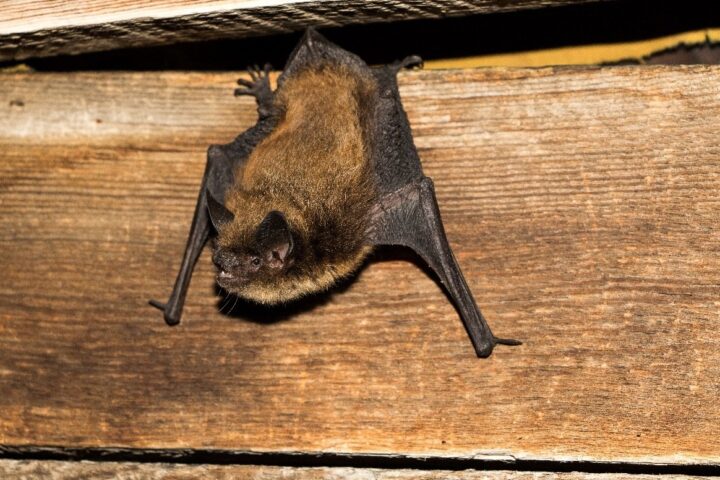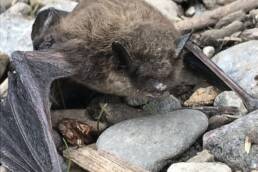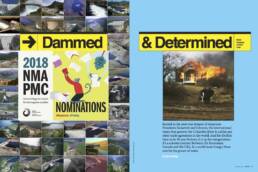With a deadly disease creeping westward, scientists and government are throwing a lifeline to the bats of Glacier National Park and beyond. By Fraser Los.
From a rocky perch in Cougar Brook Valley, in the heart of British Columbia’s Glacier National Park, my eyes adjust to starlight illuminating the steep slopes of Balu Pass. I can finally relax after helping set up bat monitoring equipment near our campsite. It’s a beautiful spot: we’re right above the famous Nakimu Cave system, which stretches six, dark kilometres beneath this lush, green surface.
In the late August chill, we have to work fast to finish before dusk, sticking long posts deep into the soil and carefully stretching barely visible netting from post to post across several cave entrances. “Have you been in any other caves with those boots?” asks bat biologist Mandy Kellner, who’s helping Parks Canada with this study. Though I won’t be setting foot in the protected Nakimu caves, she’s not taking any chances—it’s possible the spores that cause white-nose syndrome (WNS) could spread via human clothing. Biologists and parks’ officials are in a race against time as this disease makes its way west across North America.

Originally from Europe, WNS is harmless to people but devastating for bats. Estimates suggest it is responsible for killing more than 5.5 million North American bats since 2012. In some cases, it wiped out more than 90 percent of affected populations.
Named for the white fungus that grows on affected bats’ noses, WNS has been detected in Washington State, but not yet in Canada’s mountain parks or west of Ontario. “It’s not so much if, but when, it will happen,” admits Kellner, adding that we must learn more about the bats throughout these areas so we can limit the damage.
We made this trip into the valley bottom by helicopter, since hiking the trail would have been a chore. We were loaded down not just with camping gear, but with a makeshift, electric fence to surround our tents. Beyond being famous for the caves, this valley is also a hot spot for grizzly bears.
Researchers weren’t even sure that bats lived here full-time until a few years ago, when they were detected in both the early spring and late fall, suggesting they were hibernating at or near Nakimu caves. Most detections were of the Little Brown Myotis, one of three bat species, along with the Northern Myotis and Tri-colored Bat, listed as endangered in Canada because WNS threatens their survival. That gave Parks Canada a strong mandate to act.
“We’re doing whatever we can to protect bat habitat throughout mountain parks,” says Sarah Boyle, Parks Canada ecologist leading the bat study in Glacier National Park. “That means protecting any place where bats are swarming and hibernating, from old mines to natural cave systems, so they’ll stay as healthy as possible in the face of white-nose syndrome.”
She says the first step is to find out where they hibernate, then assess the health of those populations and search for any signs of WNS. Parks Canada is coordinating with other bat researchers through the North American Bat Monitoring Program, which has a mandate to monitor bats continent-wide and to prevent, or at least minimize, the spread of the disease.

We continue to discuss the plight of insect-loving bats as we keep a close watch on Kellner’s acoustic monitors, which are set up near the nets. Although they confirm extensive bat activity, we don’t catch any tonight. If we had, Kellner and Boyle would have worked fast to check for signs of WNS, often visible on wings and ears as well, recorded the species and overall health, before quickly releasing captured bats into the night sky.
“Wherever we find hibernating bats, we’ll limit public access,” says Boyle, adding the best way to ensure people don’t disturb bats or introduce WNS is to close the caves to human use.
The prognosis is grim as WNS travels westward, but there is still some hope. “West of the Rockies, bats hibernate differently,” explains Boyle, “they don’t seem to congregate in as large a group as observed east of the Rockies.” Biologists believe that may make the bats less susceptible to the disease, for now.
Related Stories
11 Sick Pics From The National Park Foundation Photo Contest
The National Park Foundation in America has announced the winners of its "Share the Experience" photo contest. And…
Lost and Found in Whistler Blackcomb’s Terrain Park
For anyone whoever needed a reminder why pipe, park and urban skiing are fun as hell, here it is. Amazing work,…
Whitefish Bike Park To Open June 17
The mountain biking season begins Saturday, June 17 at the Whitefish Bike Park in Montana. Uploads will be available…
Sorry Glacier, Hope We Didn’t Upset the Volcano
It just so happens that about six months ago, I rode my bike to the base of the glacier that once covered the volcano…
KMC Lands National Magazine Award Nomination
Kootenay Mountain Culture Magazine has landed a National Magazine Award nomination for the Columbia River Basin feature…







